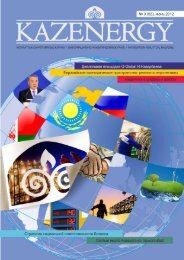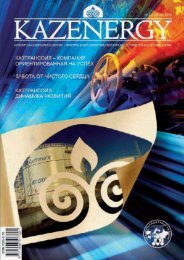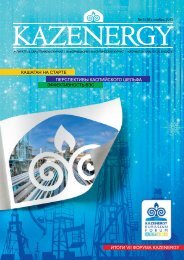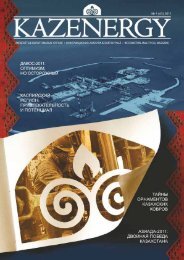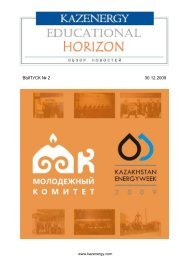â 5 (49), 2011 - KazEnergy
â 5 (49), 2011 - KazEnergy
â 5 (49), 2011 - KazEnergy
- No tags were found...
Create successful ePaper yourself
Turn your PDF publications into a flip-book with our unique Google optimized e-Paper software.
expert opinionExistingregulatorymechanismsof the worldenergy -unusable, bigcompetitionamongconsumersis fueled bythe adventof powerfulplayers, likeChina and India.84 № 5 (<strong>49</strong>), <strong>2011</strong>viding about 40% of power consumption.It is followed by natural gas (28%), coal(20%), renewables (7%) and nuclear energy(5%). Shares of oil and natural gas willrise, while the share of coal and nuclearpower - decline. It is possible that in thefuture consumption of nuclear energy willstabilize and begin to expand the scope ofalternative energy sources, but it will notaffect the basic trends, at least over thenext 15-25 years.In more distant perspective the structureof the global energy balance is likely toseek for transformation primarily by twomain scenarios.The first one means a gradual shift fromoil to gas, approximately the same whenoil replaced coal. Then, it is expected toshift to renewable sources and, obviously,to nuclear energy. The "black gold" willretain the position as an important sourceof energy, at least until the middle of theXXI century.According to the second scenario plan, ifa progress in the field of hydrogen technologies,enabling a rapid displacementof gasoline engines will take place in thecoming decade, so a reduction in oil consumptionwill begin much earlier - byabout 2025. But for now this is unlikely.The energy intensity of world economy,mainly due to the developed countries,will gradually decrease, but linear dependencebetween GDP growth and increaseof energy consumption will remain. Thecontinuing rise of the global economy forsome time will pull the energy demand.But consumption is slowing down, moreand more lagging behind rates of GDP.This means that the global economies beginto adapt to higher prices through reducingof energy consumption and use ofalternative and renewable energy.The share of energy in total expendituresof GDP of Western countries will continueto decline. This eliminates the possibility torely mainly on energy as a tool for nationaldevelopment even in the medium term.Consumption of "blue fuel" will grow mostrapidly in APR countries (an average of3.6% per year), Central and South America(3.2%), Middle East (3.1%), Africa (4 1%), increasingby cheapening and improvement ofits technological systems of transportation(including LNG) and use.The supply of gas will expand due to a numberof major projects on its extraction: inRussia (the Yamal Peninsula, Eastern Siberia,the Far East and the Kara Sea shelf),Iran (South Pars field, etc.), Qatar, SaudiArabia, UAE, Kuwait, Algeria, Libya, Azerbaijan,Kazakhstan, Turkmenistan (shelf ofthe Caspian Sea) and other regions.Due to the predictable reduction of oil outputin industrialized countries the volumeof its imports will increase substantially,especially from politically and economicallyunstable countries of Persian Gulf.Thereby, the issue of diversification of supplysources becomes topical. In this regard,it is clear what caused a growing attention ofthe major energy consuming countries andmajor international corporations to the resource-baseof states not included to OPEC.






